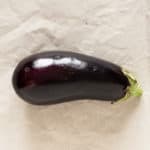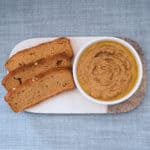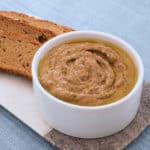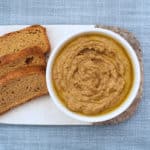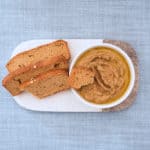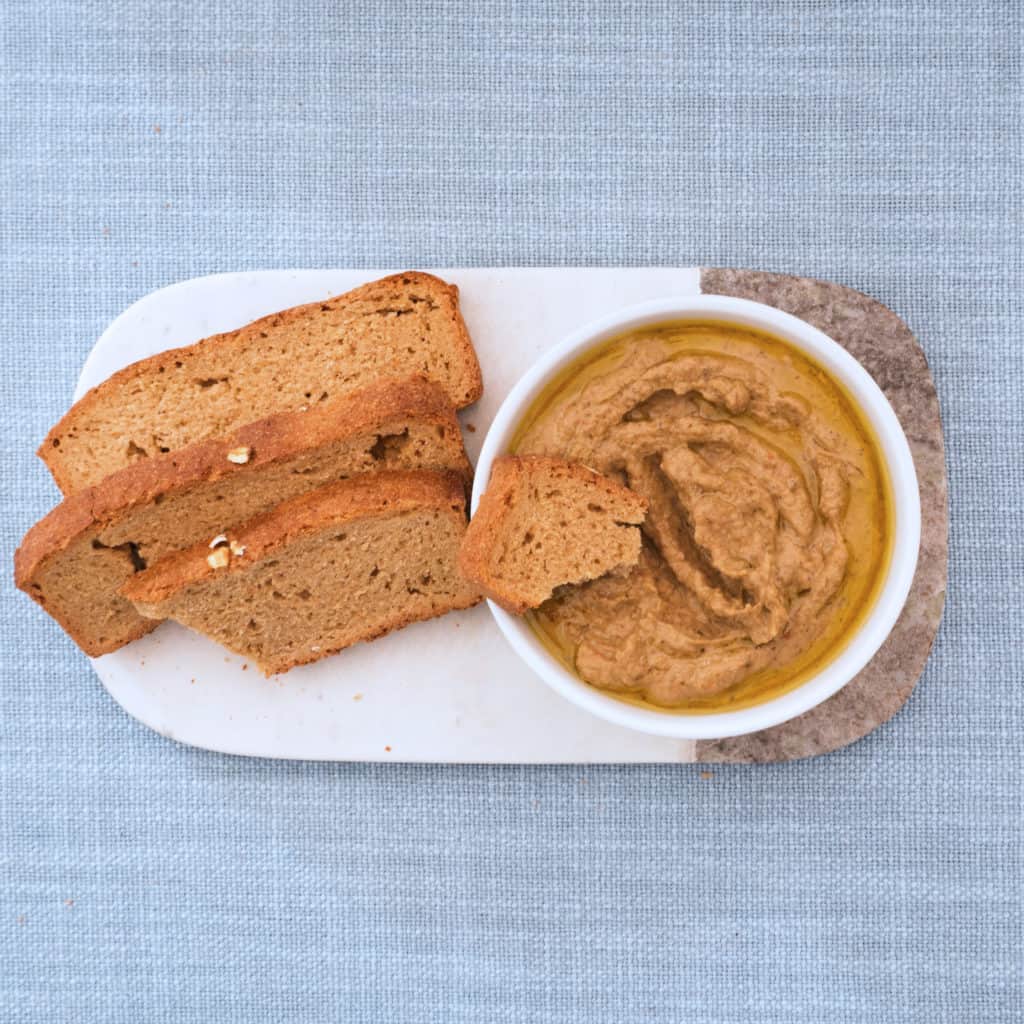
Baba Ganoush is one of those amazing dishes that is widely eaten and just happens to be gluten-free and vegan – and allergy-friendly too. As well as ticking all those boxes it is also wonderful to eat; full of deep, musky, creamy flavours of roasted aubergine that work so well with spices. I adore it drizzled with good olive oil and served with toasted gluten-free, vegan pitta bread, Garlic-Free Houmous and crudites. Sublime.
Baba Ganoush is easy to make but takes time to roast the aubergine.
You can find the full Baba Ganoush recipe here.
Perfect for a light snack, in sandwiches, lunch, light dinner dish etc. Serve with Garlic-Free Houmous , Gluten Free Vegan Rosemary and Sea Salt Crackers or as a side to a substantial salad such as Winter Vegetable Salad With Walnut Dressing
My recipe includes the skin. Most ‘classic’ recipes don’t, not sure why, I guess to keep the very light colour. However, the addition of the skin ramps up the smokey flavour and adds fibre and minor nutrients to the dish. It also reduces waste! I’m all about using the whole vegetable where possible! There is also some debate about the addition, or not, of tahini. I’ve tried both and I prefer it without the tahini. That also makes the dish sesame free. (If you want to add tahini, add one tablespoon at step 5).
Top tip. When you think the aubergine is done, leave it in the oven for at least another 10 minutes. The aubergine needs to be very well roasted.
Top tip. I recommend a food processor or immersion blender to pulp and mix the aubergine but you can do this with a good large sharp knife and elbow grease.
h1>Preparation
Difficulty easy
Preparation time 5 minutes
Cooking time 50 minutes
You can find the full Baba Ganoush recipe here.
h1>Allergens
Baba Ganoush is gluten-free and vegan as well as…
Celery free
Coconut free
Garlic free
Lupin free
Mustard free
Onion free
Peanut free
Sesame free
Soya free
Tree nut free
What’s the Deal with Aubergine?
Aubergine are super versatile and super tasty BUT only if they are cooked well. There are not many things worse than an under-cooked aubergine: rubbery, tasteless, inedible, crap!
What is aubergine?
Aubergine (AKA eggplant), Solanum melongena, is a species of nightshade, grown for its edible fruit. Aubergine is the French word for aubergine and this is used in Britain. Eggplant is the common name in North America, Australia and New Zealand. In South Asia and South Africa it is known as brinjal.
The aubergine is a delicate, tropical perennial often cultivated as a tender or half-hardy annual in temperate climates. The stem of the plant is usually spiny. The flower is white to purple, with a five-lobed corolla and yellow stamens. The egg-shaped, glossy, purple fruit has white flesh with a meaty texture. The cut surface of the flesh rapidly turns brown when the fruit is cut open.
The aubergine plant grows 40-150 centimetres tall, with large, coarsely lobed leaves that are 10-20 centirmetres long and 5-10 centimetres wide. Semi-wild types can grow much larger (up to 2.25 metres) though the fruit is much smaller in wild plants.
Botanically classified as a berry, the fruit contains numerous small, soft seeds that are edible but taste bitter because they contain nicotinoid alkaloids (like the related tobacco).
Origins and spread of aubergine
The aubergine has been cultivated in southern and eastern Asia since prehistory. The first known written record of the plant is found in Qimin Yaoshu, an ancient Chinese agricultural treatise completed in 544. The numerous Arabic and North African names for it, along with the lack of the ancient Greek and Roman names, indicate the aubergine was introduced throughout the Mediterranean area by the Arabs in the early Middle Ages. A book on agriculture by Ibn Al-Awwam in 12th-century Arabic Spain described how to grow aubergines. Records exist from later medieval Catalan and Spanish.
The aubergine is not recorded in England until the 16th century.
As a member of the nightshade family, the aubergine was at one time believed to be extremely poisonous. The flowers and leaves can be poisonous if consumed in large quantities due to the presence of solanine.
The eggplant has a special place in folklore. In 13th-century Italian traditional folklore, the eggplant can cause insanity. In 19th century Egypt, insanity was said to be “more common and more violent” when the eggplant is in season in the summer.
What do you do with aubergine?
The raw aubergine often has a bitter, astringent taste. On cooking the aubergine becomes tender and develops a rich, complex flavor. The aubergine absorbs large amounts of cooking oil and juices, this produces very rich dishes.
Many recipes advise salting, rinsing, and draining the sliced aubergine to soften it, reduce bitterness and to reduce the amount of fat absorbed during cooking. Most modern cultivars commonly imported into, and used in, western Europe do not need this treatment.
Aubergine is widely used in its native India, for example in sambar (a tamarind lentil stew), dalma (a type of dal, native to Odisha), chutney, curry, and achaar (a pickled dish). There is such a huge, wide and varied number of aubergine dishes in south Asia it is well worth researching these for yourself.
Aubergine is wonderful stewed, as in ratatouille, or deep fried aubergine takes on another rainbow of flavours and textures. Versatile is a word to apply to the aubergine!
Nutritional value of aubergine
Raw aubergine is composed of 92% water, 6% carbohydrates, 1% protein, and negligible fat. Aubergine provides low amounts of essential nutrients, with only manganese having a moderate percentage (11%) of RDA.
Aubergine is a member of the nightshade family (along with potatoes, tomatoes, peppers, chillies etc.). Many people report reactions, intolerance or allergies to this family (or members of it).
Individuals who are atopic (genetically predisposed to developing certain allergic hypersensitivity reactions) are more likely to have a reaction to eggplant, which may be because eggplant is high in histamines. Cooking eggplant thoroughly seems to preclude reactions in some individuals, but at least one of the allergenic proteins survives the cooking process.
